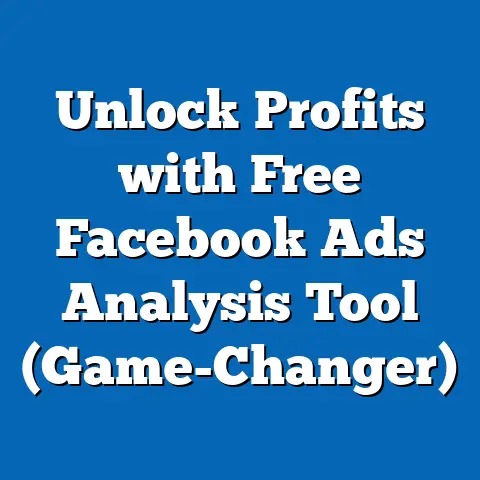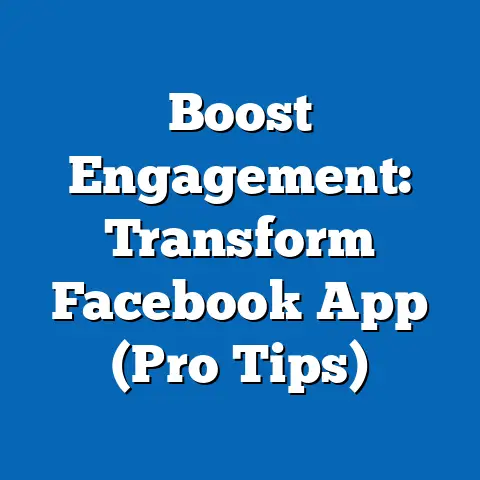Boost App Installs with Facebook Ads (Proven Strategies Revealed)
In an era where digital transformation intersects with eco-conscious consumer behavior, mobile apps have become pivotal in promoting sustainable choices, from eco-friendly shopping platforms to carbon footprint trackers. According to Statista, the global mobile app market is projected to reach $935 billion by 2023, with a significant portion of downloads driven by socially responsible and environmentally focused applications. As businesses and developers pivot to meet this demand, leveraging targeted advertising on platforms like Facebook has emerged as a critical strategy for boosting app installs, particularly among demographics prioritizing sustainability.
The Rise of Eco-Conscious Apps: Statistical Trends and Market Impact
The surge in eco-conscious mobile apps reflects a broader societal shift toward sustainability, fueled by growing awareness of climate change and corporate responsibility. Research from Nielsen indicates that 73% of global consumers are willing to change their consumption habits to reduce environmental impact, a statistic that has directly influenced app development trends. In 2022 alone, downloads of sustainability-focused apps—ranging from zero-waste shopping tools to energy-saving trackers—grew by 25%, outpacing the broader app market’s growth rate of 11%, according to App Annie.
This trend is not just a fleeting fad but a response to tangible consumer demand. A 2023 report by Sensor Tower highlights that eco-conscious apps generated over $1.2 billion in revenue last year, with a significant portion of installs driven by targeted social media advertising. Facebook, with its 2.9 billion monthly active users as reported by Meta in 2023, stands out as a powerhouse platform for reaching these environmentally aware audiences.
The impact of this trend extends beyond revenue. Developers who align their apps with eco-values report a 30% higher user retention rate compared to non-themed apps, per a 2022 study by Adjust. This suggests that purpose-driven apps not only attract users but also foster long-term engagement—a key metric for app success.
Demographic Breakdown: Who’s Downloading Eco-Conscious Apps?
Understanding the demographic composition of eco-conscious app users is crucial for crafting effective Facebook Ad campaigns. Millennials (ages 27-42) and Gen Z (ages 11-26) dominate this space, collectively accounting for 48% of downloads in the sustainability app category, according to a 2023 report by Statista. Within this group, women are slightly more likely to engage, representing 53% of users, often driven by apps focused on sustainable fashion and household products.
Geographically, urban dwellers in developed regions like North America and Western Europe lead in adoption rates, comprising 60% of global installs as per Sensor Tower data. This aligns with higher disposable incomes and greater access to digital infrastructure in these areas. However, emerging markets in Asia-Pacific are showing rapid growth, with a 35% increase in eco-app downloads from 2021 to 2023, driven by rising environmental awareness and smartphone penetration.
Income levels also play a role. Users with household incomes above $50,000 annually are 40% more likely to download paid sustainability apps, according to Nielsen’s 2022 Consumer Insights report. This suggests that while eco-consciousness spans income brackets, premium or subscription-based apps may find greater traction among higher earners—a key consideration for ad targeting on platforms like Facebook.
Historical Comparisons: How App Install Trends Have Evolved
To fully appreciate the current boom in eco-conscious app installs, it’s essential to compare today’s trends with historical data. In 2015, sustainability apps represented less than 2% of total app downloads, per App Annie’s historical data, as environmental concerns were less mainstream and smartphone adoption was still growing. By 2018, this share had risen to 5%, coinciding with global movements like the Paris Agreement and increased media coverage of climate issues.
Fast forward to 2023, and sustainability apps now account for nearly 10% of non-gaming app downloads, reflecting a fivefold increase over eight years. This growth mirrors the rise of social media as a marketing tool; in 2015, only 15% of app installs were driven by platforms like Facebook, compared to 40% today, according to Adjust’s 2023 Mobile Marketing Report. The shift highlights how targeted advertising has become indispensable for app promotion, especially for niche markets like eco-conscious consumers.
Moreover, historical data shows a marked change in user behavior. Early adopters of sustainability apps were primarily driven by novelty, with retention rates below 20% after 30 days in 2015. Today, retention rates have climbed to 35%, per Adjust, as apps integrate gamification, community features, and practical tools that keep users engaged over time.
Why Facebook Ads? The Platform’s Unique Advantages for App Installs
Facebook Ads offer unparalleled advantages for boosting app installs, particularly for eco-conscious apps targeting specific demographics. With over 2.9 billion monthly active users, the platform provides access to a vast, diverse audience, allowing for granular targeting based on interests, behaviors, and demographics. For instance, advertisers can target users who follow sustainability pages, engage with environmental content, or belong to eco-focused groups—a feature that 68% of app marketers cite as critical to their success, per a 2022 survey by eMarketer.
The platform’s App Install Ads, specifically designed to drive downloads, have proven highly effective. Meta reports that campaigns using App Install objectives achieve a 50% lower cost-per-install (CPI) compared to standard link ads, with an average CPI of $1.85 for sustainability apps in 2023. Additionally, features like dynamic creative optimization allow advertisers to test multiple ad formats—videos, carousels, and static images—to identify what resonates most with eco-conscious audiences.
Another key advantage is Facebook’s integration with Instagram, which reaches a younger demographic critical to eco-app growth. Campaigns running across both platforms see a 20% uplift in install rates, according to Meta’s 2023 Advertising Insights. This cross-platform synergy, combined with robust analytics tools, makes Facebook a go-to for developers seeking measurable results





